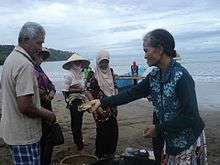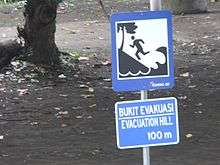East Parahyangan
East Parahyangan is a mountainous region in the southeast of Western Java, Indonesia.
Cities

- 🌍 Banjar — city at the border with Central Java, surrounded by several lakes.
- 🌍 Ciamis — historic town that was once the centre of the Galuh Kingdom.
- 🌍 Kuningan — eastern point of entry to the Ciremai volcano.
- 🌍 Majalengka — surrounded by mountains and waterfalls, western entry point to the Ciremai volcano.
- 🌍 Pangandaran — popular beach resort town with a busy fish market.
- 🌍 Tasikmalaya — also simply 'Tasik'; a regional centre, the largest city in the region.
Other destinations
- 🌍 Batu Karas — quiet beach village popular among surfers.
- 🌍 Linggajati — tiny village where the 1946 Linggadjati Agreement was negotiated during the War of Independence.
- 🌍 Mount Ciremai National Park — national park centred around the highest mountain of Western Java.
Understand
As the name implies, East Parahyangan is the eastern continuation of the mountain region of Parahyangan, which is centred around the city of Bandung. The volcanic mountain region of East Parahyangan includes the regencies of Tasikmalaya, Ciamis, Kuningan, Majalengka (the mountainous part), and Pangandaran, as well as the independent cities of Tasikmalaya and Banjar.

From about the 7th to the 15th century, the region was part of the Galuh Kingdom, a Hindu kingdom of which the capital is believed to have been in Kawali, near Ciamis. After the fall of the Galuh Kingdom and its neighbour the Sunda Kingdom (based in Bogor Raya), the region came under the control of the sultanate of Cirebon and the Mataram Sultanate from Central Java. Soon after, the colonial powers from Europe came to Java, and the Dutch East India Company (VOC) settled in Batavia (Jakarta). By the early 18th century also the entire Parahyangan region was under Dutch control.
Get in
By plane
The new Kertajati International Airport (KJT IATA) is intended to be the main airport of the region. There is one small airport in the region with scheduled flights. Nusawiru Airport (CJN IATA) near the town of Cijulang is along the road from Pangandaran to Batu Karas on the south coast. It is served by scheduled flights from Halim Airport in East Jakarta operated by Susi Air. The nearest larger airport is in Bandung (BDO IATA), with flights from major cities throughout Indonesia as well as Singapore and Malaysia. Especially to get to the northern part of East Parahyangan (such as Majalengka) it is also a good option to fly to Jakarta's major Soekarno-Hatta International Airport, as the tolled motorways allow for a quick journey.
By train
There is one operational railway in East Parahyangan, that runs from west to east centrally through the region. The largest railway stations are in Tasikmalaya and Banjar, which are both served by about a dozen daily trains in both directions: to the west (Bandung, some of them further to Jakarta) and to the east (Central Java, some of them further to East Java). The railway station in Ciamis is also served by long-distance trains, but fewer than Tasik and Banjar.
By bus
All of the larger towns and cities have intercity bus terminals. Especially the Southern Java Route (the road from Bandung via Tasikmalaya to Yogyakarta) sees many long-distance buses, and as a result Tasikmalaya, Ciamis, and Banjar have very good connections to the west (mainly Bandung and Greater Jakarta) and the east (mainly Central Java but also East Java). In addition to these cities, all other towns have at least bus connections to Jakarta and Bandung, and in the northern part of the region also connections to Cirebon are plenty.
Get around
The larger towns and cities are interconnected by a network of buses. Within the city of Tasikmalaya as well as the other larger towns it is easy to get around using a dense network of angkot (public minivans). To and within more remote areas of the region, public transport is more limited. During weekends and holidays, traffic congestion is common on the roads to tourist destinations, such as the beach of Pangandaran.
While there are some taxi companies in Tasikmalaya, in other parts of the region this is more limited. However, in all towns and villages you can rent an ojek (motorcycle taxi), which are usually available at all major street corners. Other transport options in some places include becak (bicycle rickshaws), and delman (horse carriages).
See

There are various active volcanoes in the region. The most well-known volcano is Mount Ciremai, that forms the centre of the Mount Ciremai National Park. You can climb the volcano from several sides, and if you are lucky see the endangered Javan surili monkey and Javan hawk-eagle. Other volcanoes that can be climbed include Mount Galunggung near Tasikmalaya and Mount Sawal near Ciamis.
Along the Indian Ocean coast, there are various beaches. The most well-known beach town in the region is Pangandaran, with a nature park with a beautiful white sand beach with monkeys, many accommodations, and a busy fish market. About 40 km from Pangandaran is the smaller village of Batu Karas, that is mainly known for its beginner surf break. Between Pangandaran and Batu Karas there is the 'green canyon', a beautiful river among jungle and rocks. Also along the remainder of the coast there are beaches, but these are less touristic.
The number of historic sights is relatively limited in the region, although in most towns usually some buildings are remnants of the colonial time, such as railway stations, government buildings, and post offices. However, near Ciamis the Astana Gede inscriptions can be found, which are 14th century inscriptions from the Galuh Kingdom. Another place of historic interest is the village of Linggajati. During the Indonesian War of Independence the Linggadjati Agreement of 1946 was negotiated here, between the Dutch administration and the self-proclaimed Republic of Indonesia. The negotiation buildings is now a museum. Near Tasikmalaya you can find the village of Kampung Naga, where the community still lives with traditional simplicity and environmental wisdom.
Do
Surfing is a popular activity at the Indian Ocean beaches. Pangandaran has a long beach break, and various facilities such as surf schools and rental places. Batu Karas is much smaller, but its right hand wave is arguable one of the best beginner surf breaks in the world. There is no surf school, but you can rent boards, and the locals are willing to teach you how to surf.
In the other parts of the region, trekking is popular at the volcanoes. One of the most popular mountain climbing routes starts at the historical village of Linggajati, and goes from there up the Ciremai volcano. However, for enjoying the nature you don't need to go all the way up a volcano. The green canyon is a popular tourist attraction near Batu Karas, and in the surroundings of Majalengka there are several impressive water falls.
A popular thing to do among locals during weekends and holidays is to visit one of the water parks (with swimming pools and water slides). Some of the largest in the region can be found in Banjar, Kuningan, and Majalengka.
Eat

The traditional food from the region, Sundanese food, is ubiquitous, and can be found everywhere from major hotels to roadside food stalls. The food is characterised by fresh (often raw) vegetables, sambal terasi (chili sauce with shrimp paste), and fried tofu and tempeh. In traditional Sundanese restaurants, it is common to sit on a bamboo mat on the floor, and eat with your hands. A small bowl of water is provided to clean your hands before eating.
Some typical types of food specifically in East Parahyangan include nasi tutug oncom (rice mixed with fermened soy bean tailings) in Tasikmalaya and the galendo snack (made of coconut milk) in Ciamis. Of course, fresh fish and seafood can be found along the Indian Ocean coast, with the largest fish market being in Pangandaran.
Drink
Along the beaches of Pangandaran and Batu Karas you can find alcoholic beverages. In the remainder of the region cafés that sell alcoholic drinks are less common, but usually you can buy Bintang beer at least in the hotels and resorts.
Stay safe

Be aware that there are several active volcanoes in the area. Make sure to be informed about the latest situation on eruptions and volcanic activity from the Indonesian authorities when you want to climb a volcano. Along the south coast there is a risk of tsunamis. There is a tsunami warning system and there are tsunami escape routes. When you arrive, have a look at the signs so you know where to go in case of a warning.
Keep also in mind that traffic is busy and chaotic. If you are not used to driving in Indonesia, it is better to use public transport or to hire a car with a driver rather than attempting to drive by yourself.
Go next
- Parahyangan — more volcanoes, and the city of Bandung (the 'Paris of Java').
- North Coast of West Java — beaches on the Java Sea coast, and the 'city of shrimps' Cirebon.
- Purwokerto — city in Central Java at the base of Slamet volcano.